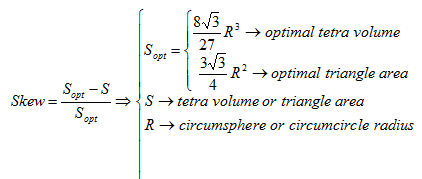Surface Mesh Improver Flag
Surface mesh improver flag is set to Off by default. Turning it On provides additional options for surface mesh improvement.
All of the options are discussed in detail below.
- Surface improver optimization flag turns on/off topological optimization during surface mesh improvement. The Default is On.
- Surface improver grade mesh flag sets the mesh size gradation rate for improvement refinement. In order to meet the shape metric criteria, the surface mesh improver may locally refine the mesh. Surface improver gradation rate sets the maximum gradation rate from the refined entities. Values of surface improver gradation rate should be in the (0...1] range (0 is not supported). The smaller the rate, the finer the mesh, and the slower the meshing process. A rate of 2/3 approximately matches the default transition.
- Surface improver fix intersections flag controls whether the surface mesh improver performs intersection checks. If the surface mesh is refined, a self-intersecting mesh can be created. An example of this is a coarse mesh of concentric cylinders. If the mesh on the inner cylindrical surface is refined, it can intersect the mesh on the outer cylinder. The volume mesher will fail if the surface mesh self-intersects. See Surface mesh fix intersections flag for more information.
- Surface improver min refinement flag allows the mesh improver to refine the mesh to meet the specified criteria. When this is turned On, the mesh improver will be permitted to refine the mesh in areas where required to meet the specified criteria. The size passed in is the minimum size to which the mesh will be refined. Select the Surface improver refinement type and specify the Surface improver refinement size.
Surface improver shape metric type sets the criteria to be used for mesh improvement. Elements with a shape metric worse than the set value are targeted for optimization and smoothing, while most bad elements worse than the target value are eliminated, it is not guaranteed due to model tangencies or other constraints. Three different shape metric criteria can be set.
- Max Angle: Maximum triangle or tetrahedron dihedral angle in degrees. The default value is 145 degrees. The value must be in the range 145 degrees ≤ Max Angle < 180 degrees.
- Skewness: Equiarea or equivolume skewness is a non-dimensional parameter with range 0
(equilateral triangle or tetrahedron) - 1(degenerate element) defined as

Figure 1.
Quality meshes of complex models typically have tetrahedra with equivolume skew < 0.9 and surface triangles with skew < 0.8. Default values are 0.85 (tetras) and 0.7 (triangles)
- Aspect Ratio: Triangle or tetrahedral aspect ratio is a non-dimensional normalized parameter
with range 1.0 (equilateral best case) - ∞(degenerate) defined as:

Figure 2.
The default value for tetrahedral is 12.0 and for triangles it is 6.0.